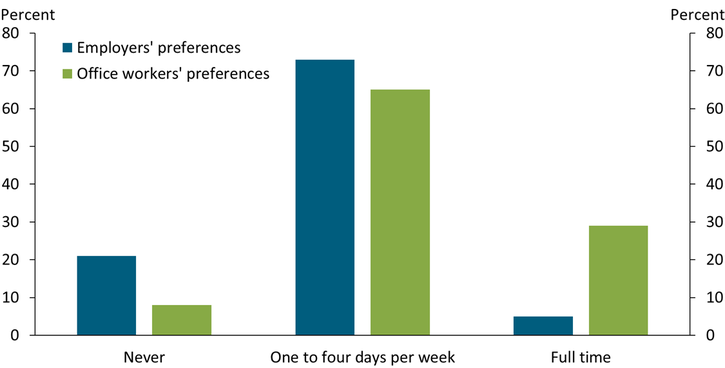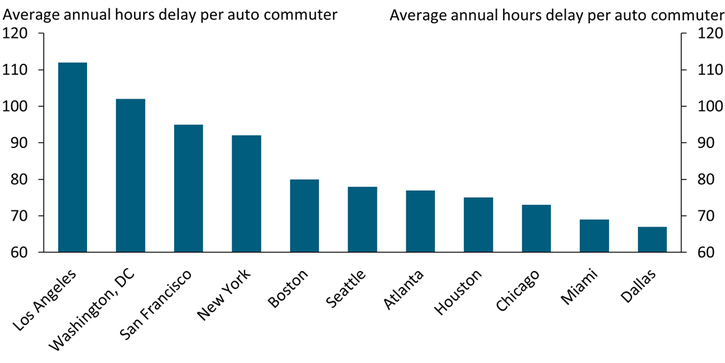Remote work has surged during the COVID-19 pandemic. Survey estimates suggest that as many as half of all employees worked remotely on a regular basis during the pandemic, up from approximately 15 percent previously (Brynjolfsson and others 2020). This shift does not appear to have made workers less productive. In a June 2020 PwC survey, almost half of U.S. business executives reported that employee productivity had actually improved while sheltering at home, and another quarter reported that productivity remained about the same. As a result, many employers have expressed a willingness to let employees work remotely after the pandemic has ended, but only part of the time. Chart 1 shows the results of a January 2021 PwC survey: a strong majority of business executives surveyed say that office employees could work remotely one to four days per week without sacrificing company culture, a preference that matches that of their employees.
Chart 1: After the Pandemic, Office Workers Are Likely to Work Remotely One to Four Days per Week

Source: PwC (2021).
A shift toward remote work will likely reduce commuting time for most workers—not just those working remotely. Of course, those who are able to work remotely will have fewer daily commutes. But the associated decrease in commuting volume should also significantly reduce traffic congestion, cutting the travel time of all those who drive to work. Dingel and Neiman (2020) estimate that more than one-third of jobs can be done remotely. If the employees holding such jobs on average work from home two days per week, daily commuting volume would fall by more than 10 percent. The potential increases in driving speed, based on speed’s relationship with volume and fixed highway capacity, could cut travel times most where traffic congestion has been worst. For example, a 10 percent decrease in volume on a highway segment where traffic had previously slowed speed to 45 mph would cut driving time by about 20 percent. On a highway segment where traffic had previously slowed speed to 25 mph, the same 10 percent decrease in commuting volume would cut driving time by 40 percent._ An important caveat is that decreased traffic congestion may induce some commuters to switch to driving from other modes of travel, limiting potential speed gains. This is especially a concern in the New York City metropolitan area, where weekday ridership of commuter rail in 2019 was close to 700,000.
Large metropolitan areas may benefit most from decreased commuting volumes, as they have tended to have the worst traffic congestion and longest commutes. Chart 2 shows the average annual hours of delay from traffic congestion in 2017 experienced by auto commuters in the 11 metropolitan areas where delays were highest. All had populations above 3 million. One-way commute times in 2000, measured by the 90th percentile duration of rush-hour drives to central business districts, averaged 37 minutes for metros with populations from 1 million to 3 million, 50 minutes for metros with populations from 3 million to 8 million, and 62 minutes for metros with populations above 8 million._
Chart 2: Metros Where Commuters Faced the Longest Delays Due to Traffic Congestion in 2017

Note: The Los Angeles metro includes Riverside-San Bernadino; the San Francisco metro includes San Jose.
Sources: Schrank, Eisele, and Lomax (2019) and author’s calculations.
The reduction in commutes and faster driving speeds made possible by hybrid officing have the potential to reshape where people live and where employers locate within metropolitan areas. In particular, workers will likely be willing to live farther from their employers, boosting residential construction in the outer suburbs of metropolitan areas. The more plentiful land available for development there removes a key bottleneck that has constrained single-family construction in recent years, and could lay a foundation for a ramp-up in home building that is sustainable for many years. Single-family construction has already responded vigorously, with housing starts rising 29 percent from February 2020 to December 2020.
The increased willingness to live far from an employer does not necessarily imply that people will abandon living near core business districts. To be sure, rents and home prices in central locations may fall relative to rents and home prices farther away, making living near the center of a metropolitan area more affordable for younger households. More importantly, urban amenities—such as restaurants, cafes, galleries, performance venues, and pedestrian retail districts—have been a key force over the past 20 years in pulling young college graduates to live in metropolitan centers and are likely to remain a powerful source of attraction (Couture and Handbury 2019). More generally, reduced traffic congestion lessens a disincentive to living in medium and large metropolitan areas and so may attract population from smaller places, allowing for growth in outer suburbs without depleting the population living closer to the center.
Nor does the increased willingness to live far from an employer imply that workers can live anywhere. Most employees surveyed want to work remotely only part of the time, and few employers seem willing to let them do so full time. Hybrid officing arrangements relax the physical tether to employers but do not break it. Thus, smaller locations more than a few hours’ drive from major employment centers may not benefit much from the shift to hybrid officing. In sum, hybrid officing may support migration to the outlying suburbs of medium and large metropolitan areas but not migration away from such metropolitan areas entirely.
In addition to reshaping residential development, hybrid officing may also reshape commercial development, albeit in an opposite way. In particular, hybrid officing may encourage employers to shift offices from suburbs to core cities. Formerly, suburban offices had two key advantages: ample parking and short commutes for suburban residents. However, downtown parking constraints and commuting delays are likely to ease with hybrid officing, reducing these advantages. Although suburban office space is typically less expensive than urban office space, this, too, may become less important. With fewer employees working in person each day, hybrid officing may allow businesses to cut down on leased space, lowering office rent as a share of their expenses. In addition, the aggregate effect of businesses reducing leased space will be downward pressure on office rents in both central and suburban locations, further lowering rent as a share of business expenses. Lastly, the nearby presence of urban amenities may become an increasing advantage of locating in core cities. Over the past decade, hundreds of organizations have already relocated offices from suburbs to city centers._ Leaders of many of these organizations attribute the relocations to an improved ability to recruit and retain younger workers, who they say prefer to work in pedestrian neighborhoods with diverse non-office activities.
The shift in the location of residences and workplaces induced by hybrid officing is likely to play out over several decades, similar to the shifts from cities to suburbs and from colder locations to the Sun Belt. Especially during the first part of this extended transition, workers and employers are likely to experiment with how to balance the flexibility and time savings of remote work with the collaboration, team building, and closer supervision of working in person. Similarly, developers are likely to experiment with building homes that better meet the needs of a remote workforce and office spaces that better match the fluidity of daily attendance.
Interested in learning more about the economics of where you work? External LinkClick here.
Endnotes
-
1
I calculate the increase in driving speed and associated reduction in travel time using the updated Bureau of Public Roads function and recommended parameters for freeways reported in Small and Verhoef (2007).
-
2
I calculate average duration using data summarized in Rappaport (2016).
-
3
Smart Growth America (2015) lists more than 450 organizations that increased their leasing of downtown office space. Among these, 244 relocated from suburbs to city centers.
References
Brynjolfsson, Erik, John J. Horton, Adam Ozimek, Daniel Rock, Garima Sharma, and Hong-Yi TuYe. 2020. “External LinkCOVID -19 and Remote Work: An Early Look at U.S. Data.” National Bureau of Economic Research, working paper no. 23744, June.
Couture, Victor, and Jessie Handbury. 2019. “Urban Revival in America, 2000 to 2010.” National Bureau of Economic Research, working paper no. 24084, June.
Dingel, Jonathan, and Brent Neiman. 2020. “Who Can Work at Home?” Centre for Economic Policy Research, Covid Economics, Vetted and Real-Time Papers, no. 1, April.
PwC. 2021. “External LinkIt’s Time to Reimagine Where and How Work Will Get Done: PwC’s U.S. Remote Work Survey, January 12, 2021.” PwC, January 12.
———. 2020. “External LinkWhen Everyone Can Work from Home, What’s the Office For? PwC’s U.S. Remote Work Survey, June 25, 2020.” PwC, June 25.
Rappaport, Jordan. 2016. “External LinkProductivity, Congested Commuting, and Metro Size.” Federal Reserve Bank of Kansas City, Research Working Paper no. 16-03, January.
Schrank, David, Bill Eisele, and Tim Lomax. 2019. External Link2019 Urban Mobility Report. Texas A&M Transportation Institute, August.
Small, Kenneth A., and Erik T. Verhoef. 2007. The Economics of Urban Transportation. London: Routledge.
Smart Growth America. 2015. “External LinkCore Values: Why American Companies Are Moving Downtown.” Smart Growth America, June.
Jordan Rappaport is a senior economist at the Federal Reserve Bank of Kansas City. The views expressed are those of the author and do not necessarily reflect the positions of the Federal Reserve Bank of Kansas City or the Federal Reserve System.
